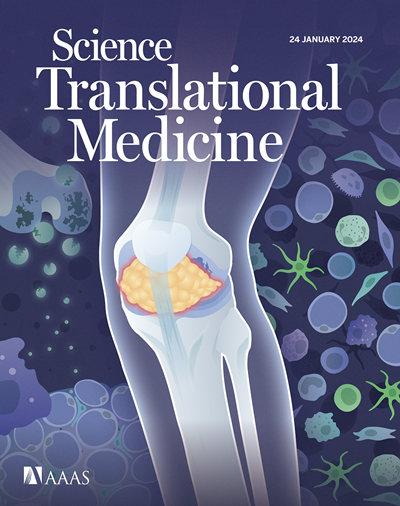Acyl-CoA binding protein for the experimental treatment of anorexia
IF 15.8
1区 医学
Q1 CELL BIOLOGY
引用次数: 0
Abstract
Extracellular acyl-coenzyme A binding protein [ACBP encoded by diazepam binding inhibitor (DBI)] is a phylogenetically ancient appetite stimulator that is secreted in a nonconventional, autophagy-dependent fashion. Here, we show that low ACBP/DBI plasma concentrations are associated with poor prognosis in patients with anorexia nervosa, a frequent and often intractable eating disorder. In mice, anorexia induced by chronic restraint stress (CRS) is accompanied by a reduction in circulating ACBP/DBI concentrations. We engineered a chemical-genetic system for the secretion of ACBP/DBI through a biotin-activatable, autophagy-independent pathway. In transgenic mice expressing this system in hepatocytes, biotin-induced elevations in plasma ACBP/DBI concentrations prevented anorexia induced by CRS or chemotherapeutic agents including cisplatin, doxorubicin, and paclitaxel. ACBP/DBI reversed the CRS or cisplatin-induced increase in plasma lipocalin-2 concentrations and the hypothalamic activation of anorexigenic melanocortin 4 receptors, for which lipocalin-2 is an agonist. Daily intravenous injections of recombinant ACBP/DBI protein or subcutaneous implantation of osmotic pumps releasing recombinant ACBP/DBI mimicked the orexigenic effects of the chemical-genetic system. In conclusion, the supplementation of extracellular and peripheral ACBP/DBI might constitute a viable strategy for treating anorexia.

用于实验性治疗厌食症的 Acyl-CoA 结合蛋白。
细胞外酰基辅酶 A 结合蛋白[ACBP,由地西泮结合抑制剂(DBI)编码]是一种系统发育古老的食欲刺激物,它以一种非常规的、依赖于自噬的方式分泌。在这里,我们发现低 ACBP/DBI 血浆浓度与神经性厌食症患者的不良预后有关,神经性厌食症是一种常见的、往往难以治愈的进食障碍。在小鼠中,慢性束缚应激(CRS)诱发的厌食症伴随着循环 ACBP/DBI 浓度的降低。我们设计了一个化学遗传系统,通过生物素激活的、不依赖自噬的途径分泌 ACBP/DBI。在肝细胞中表达该系统的转基因小鼠中,生物素诱导的血浆 ACBP/DBI 浓度升高可防止 CRS 或包括顺铂、多柔比星和紫杉醇在内的化疗药物诱导的厌食症。ACBP/DBI 逆转了 CRS 或顺铂诱导的血浆脂褐素-2 浓度的增加,以及下丘脑对厌食性黑皮素 4 受体的激活,而脂褐素-2 是黑皮素 4 受体的一种激动剂。每天静脉注射重组 ACBP/DBI 蛋白或皮下注射释放重组 ACBP/DBI 的渗透泵可模拟化学遗传系统的促厌食效应。总之,补充细胞外和外周 ACBP/DBI 可能是治疗厌食症的一种可行策略。
本文章由计算机程序翻译,如有差异,请以英文原文为准。
求助全文
约1分钟内获得全文
求助全文
来源期刊

Science Translational Medicine
CELL BIOLOGY-MEDICINE, RESEARCH & EXPERIMENTAL
CiteScore
26.70
自引率
1.20%
发文量
309
审稿时长
1.7 months
期刊介绍:
Science Translational Medicine is an online journal that focuses on publishing research at the intersection of science, engineering, and medicine. The goal of the journal is to promote human health by providing a platform for researchers from various disciplines to communicate their latest advancements in biomedical, translational, and clinical research.
The journal aims to address the slow translation of scientific knowledge into effective treatments and health measures. It publishes articles that fill the knowledge gaps between preclinical research and medical applications, with a focus on accelerating the translation of knowledge into new ways of preventing, diagnosing, and treating human diseases.
The scope of Science Translational Medicine includes various areas such as cardiovascular disease, immunology/vaccines, metabolism/diabetes/obesity, neuroscience/neurology/psychiatry, cancer, infectious diseases, policy, behavior, bioengineering, chemical genomics/drug discovery, imaging, applied physical sciences, medical nanotechnology, drug delivery, biomarkers, gene therapy/regenerative medicine, toxicology and pharmacokinetics, data mining, cell culture, animal and human studies, medical informatics, and other interdisciplinary approaches to medicine.
The target audience of the journal includes researchers and management in academia, government, and the biotechnology and pharmaceutical industries. It is also relevant to physician scientists, regulators, policy makers, investors, business developers, and funding agencies.
 求助内容:
求助内容: 应助结果提醒方式:
应助结果提醒方式:


